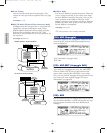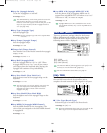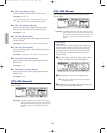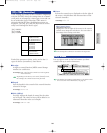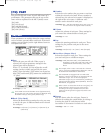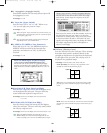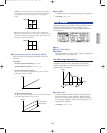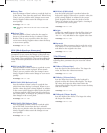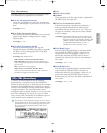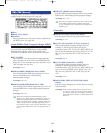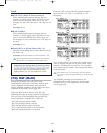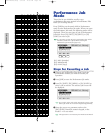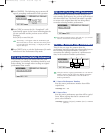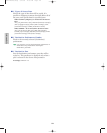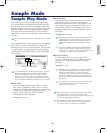
Performance Mode
168
■ Decay Time
Sets the amount of time it takes to reach the level set
in the Decay Time, from the peak level. When Decay
Time is set to a positive value, change occurs more
slowly. Negative values cause the change to occur
more quickly.
❏ Settings: –64~0~+63
The Decay Time are set for each voice in Voice Edit
mode.
■ Release Time
Sets the amount of time it takes for the sound to
decay to 0, from when the key is released. When
Release Time is set to a positive value, the decay
occurs more slowly. Negative values cause the decay
to occur more quickly.
❏ Settings: –64~0~+63
PEG (Pitch Envelope Generator)
For setting the PEG for each part. The following four
parameters let you create the change of the pitch over
time, from when the key is played until it is released.
The Attack Time and Release Time set here offset the
value of the same parameters in the EG in Voice Edit
mode.
■ PEG Atck (PEG Attack)
Sets the amount of time it takes to reach the correct
pitch, from when a note is played. When Attack
Time is set to a positive value, the change is more
slowly. Negative values cause change to occur more
quickly.
❏ Settings: –64~0~+63
■ PEG RelL (PEG Release Level)
Sets the amount of time it takes to reach the last
pitch, from when the key is released. When set to a
positive value, the pitch is sharp (higher) in relation
to the correct pitch. Negative values cause the pitch
to change towards a flat (lower) pitch in relation to
the correct pitch. A setting of “0” produces a sound
that changes to the correct pitch.
❏ Settings: –64~0~+63
■ PEG RelT (PEG Release Time)
Sets the amount of time it takes to reach the pitch
set in PEG RelL, from when the key is released.
When set to a positive value, the change occurs more
slowly. Negative values cause the change to occur
more quickly.
❏ Settings: –64~0~+63
■ PEG Init (PEG Initial)
Sets the initial pitch that is produced when the
keyboard is played. When set to a positive value, the
pitch is sharp (higher) in relation to the correct
pitch. Negative values cause the pitch to be flat
(lower) in relation to the correct pitch. A setting of
“0” produces the correct pitch.
❏ Settings: –64~0~+63
■ Bright
Adjusts the cutoff frequency for the filter that is set
for the voice. The values 0~127 are converted to
–64~0~+63, and added to the original voice data.
❏ Settings: –64~0~+63
■ Harmonic
Adjusts the filter resonance that is set for the voice.
The values 0~127 are converted to –64~0~+63,
and added to the original voice data.
❏ Settings: –64~0~+63
Vib (Vibrato)
Settings related to the vibrato effect for each part. The
following three parameters let you create the vibrato
effect.
■ VibRate (Vibrato Rate)
Sets the speed of the vibrato effect. The larger the
value, the faster the vibrato movement.
❏ Settings: –64~0~+63
■ VibDelay (Vibrato Delay)
Sets the delay time, from when the keyboard is
played to when the vibrato effect begins. The larger
the value, the longer the delay time before the
vibrato effect begins. Negative values cause the delay
time to be shorter.
❏ Settings: –64~0~+63
■ VibDepth (Vibrato Depth)
Sets the depth of the vibrato. The larger the value,
the deeper the vibrato.
❏ Settings: –64~0~+63
Performance/E/qx 5/21/98 11:35 AM Page 168



